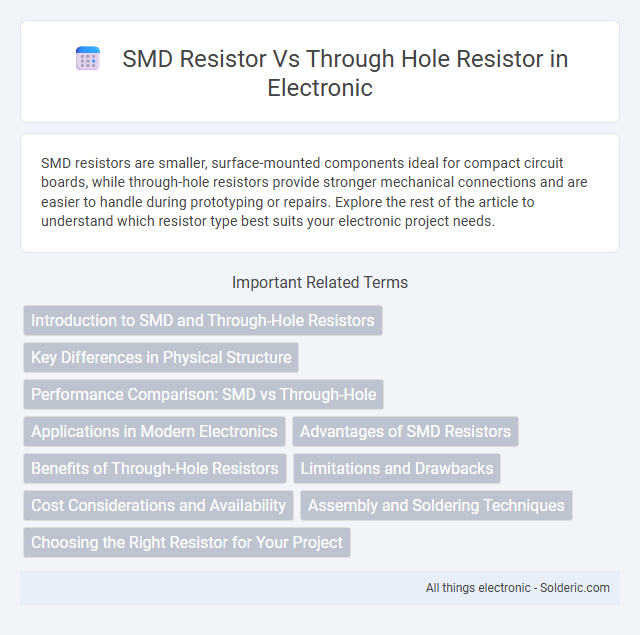SMD resistors are smaller, surface-mounted components ideal for compact circuit boards, while through-hole resistors provide stronger mechanical connections and are easier to handle during prototyping or repairs. Explore the rest of the article to understand which resistor type best suits your electronic project needs.
Comparison Table
| Feature | SMD Resistor | Through-Hole Resistor |
|---|---|---|
| Mounting Type | Surface Mount Device (SMD) | Leaded, through PCB holes |
| Size | Compact, typically 0805, 0603 sizes | Larger, varies by wattage |
| Power Rating | 0.05W to 0.5W typical | 0.25W to 5W or more |
| Manufacturing | Compatible with automated pick-and-place assembly | Requires manual or wave soldering |
| Performance | Lower inductance, suitable for high-frequency circuits | Higher inductance, less ideal at high frequency |
| Reliability | Good for compact, high-density boards | Better mechanical strength for high-vibration environments |
| Cost | Generally lower cost in high volume | Higher cost due to manual assembly |
Introduction to SMD and Through-Hole Resistors
SMD resistors, or Surface-Mount Device resistors, are compact components designed for automatic placement on the surface of printed circuit boards (PCBs), enabling high-density and miniaturized electronic assemblies. Through-hole resistors feature leads that pass through drilled holes in PCBs, providing robust mechanical connections ideal for applications requiring durability and ease of manual soldering. The choice between SMD and through-hole resistors impacts assembly efficiency, space utilization, and mechanical stability in electronic circuit design.
Key Differences in Physical Structure
SMD resistors feature a compact, rectangular shape with metal terminals on either end, designed for mounting directly on the surface of a printed circuit board (PCB), whereas through-hole resistors have cylindrical bodies with leads extending from both ends for insertion into drilled holes on the PCB. The smaller size and low profile of SMD resistors enable higher component density and automated assembly, while through-hole resistors are bulkier and preferred for applications requiring stronger mechanical bonds or easier manual soldering. Understanding these physical structure differences helps you choose the appropriate resistor type based on space constraints and manufacturing methods.
Performance Comparison: SMD vs Through-Hole
SMD resistors offer superior high-frequency performance due to their lower parasitic inductance and capacitance compared to through-hole resistors, making them ideal for modern compact electronics. Through-hole resistors typically provide better mechanical strength and power dissipation, which benefits applications requiring durability and higher wattage handling. For your designs demanding precision and compactness, SMD resistors deliver enhanced electrical performance, while through-hole components excel in rugged environments.
Applications in Modern Electronics
SMD resistors are preferred in modern electronics due to their compact size, making them ideal for densely packed circuit boards in smartphones, laptops, and wearable devices. Through hole resistors are still widely used in applications requiring higher power dissipation and mechanical strength, such as automotive electronics and industrial machinery. Your choice between SMD and through hole resistors depends on space constraints, manufacturing techniques, and durability requirements.
Advantages of SMD Resistors
SMD resistors offer significant advantages over through-hole resistors, including smaller size and higher packing density, which enable greater circuit miniaturization and improved performance in compact electronic devices. They provide better thermal performance and more accurate resistance values due to their precise manufacturing processes. SMD resistors also support automated assembly techniques, increasing production speed and reducing labor costs in mass manufacturing.
Benefits of Through-Hole Resistors
Through-hole resistors offer superior mechanical strength and durability due to their leaded design, making them ideal for applications subjected to high stress or vibration. They facilitate easier manual soldering and prototyping, allowing quick adjustments and repairs. Their larger size enables higher power dissipation compared to SMD resistors, supporting robust performance in demanding electronic circuits.
Limitations and Drawbacks
SMD resistors exhibit size limitations that restrict power dissipation, typically maxing out around 0.25 watts, which can be insufficient for high-power circuits, unlike through-hole resistors that handle higher wattages more effectively. Handling and manual soldering of SMD resistors pose challenges due to their small size, increasing the risk of damage or misplacement during assembly, whereas through-hole resistors offer easier manual installation and inspection. Thermal management is more critical for SMD resistors as their compact design leads to greater heat accumulation, potentially affecting performance and lifecycle compared to the more robust heat dissipation in through-hole components.
Cost Considerations and Availability
SMD resistors typically offer lower manufacturing and assembly costs due to their compatibility with automated surface-mount technology, making them highly cost-effective for high-volume production. Through-hole resistors incur higher labor costs as they require manual insertion or wave soldering, but their widespread availability and ease of prototyping remain advantageous for low-volume or hobbyist projects. Market availability favors SMD resistors in modern electronics, though through-hole components maintain consistent supply across various resistance values and power ratings.
Assembly and Soldering Techniques
SMD resistors are designed for surface-mount technology, allowing automated pick-and-place machines to position them precisely on PCB pads before reflow soldering creates consistent, high-quality joints. Through-hole resistors require manual or wave soldering, where leads are inserted into drilled holes and soldered, providing strong mechanical bonds but increasing assembly time and complexity. SMD assembly offers higher production speed and is preferred for compact, high-density boards, while through-hole soldering remains common in prototyping and applications needing robust mechanical stability.
Choosing the Right Resistor for Your Project
SMD resistors offer compact size and automatic assembly advantages, making them ideal for high-density PCB designs, while through-hole resistors provide robust mechanical strength suitable for prototypes and higher power applications. Your project requirements such as space constraints, power rating, and assembly method will determine the best choice between SMD and through-hole resistors. Consider factors like ease of repair, manufacturing volume, and thermal dissipation to select the appropriate resistor type that ensures reliable circuit performance.
SMD resistor vs through hole resistor Infographic

 solderic.com
solderic.com